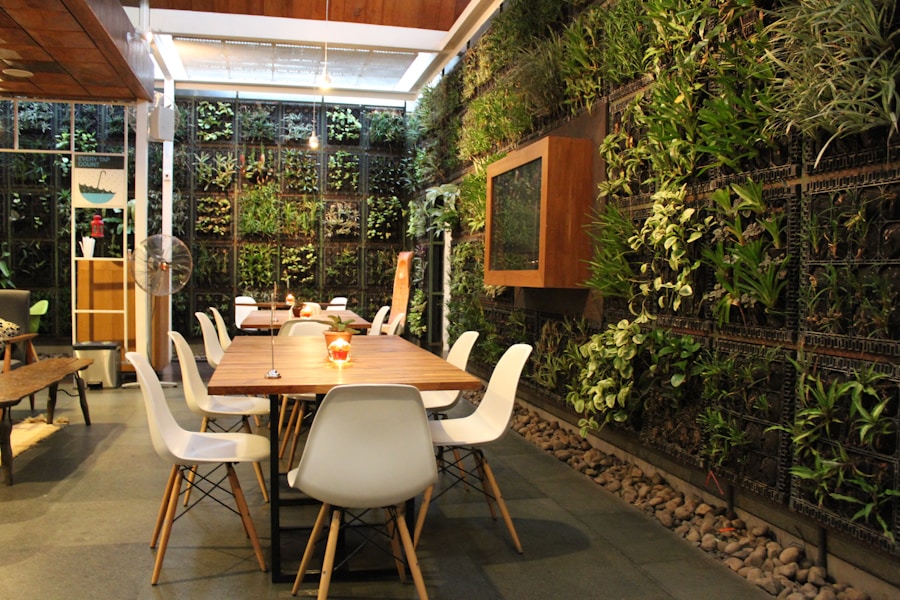Biophilic design is an innovative approach that seeks to reconnect individuals with nature through the built environment. This concept is rooted in the idea that humans have an inherent affinity for the natural world, a notion supported by the biophilia hypothesis proposed by American biologist Edward O. Wilson. Biophilic design integrates natural elements into architectural and interior design, creating spaces that foster a sense of well-being and harmony. By incorporating features such as natural light, vegetation, water elements, and organic materials, biophilic design aims to create environments that resonate with the human experience. The principles of biophilic design extend beyond mere aesthetics; they encompass a holistic understanding of how natural elements can influence human behavior and emotions. This design philosophy emphasizes the importance of sensory experiences, encouraging designers to consider how spaces can evoke feelings of tranquility, inspiration, and connection to the environment. As urbanization continues to dominate modern life, the need for biophilic design becomes increasingly critical, offering a remedy to the disconnection many individuals feel from nature in their daily lives.
Key Takeaways
- Biophilic design is the practice of incorporating natural elements into the built environment to create a connection with nature.
- Biophilic design has been shown to have numerous health benefits, including reducing stress, improving cognitive function, and boosting mood.
- Incorporating biophilic design into indoor spaces can enhance productivity by reducing distractions, increasing creativity, and improving overall well-being.
- Urban environments can benefit from biophilic design through the integration of green spaces, natural light, and natural materials to create a more harmonious and healthy living environment.
- Implementing biophilic design in the workplace can be achieved through the use of natural materials, indoor plants, and access to natural light to create a more inviting and productive work environment.
The Benefits of Biophilic Design on Health
Mental Health Benefits
For instance, studies indicate that individuals who spend time in environments enriched with greenery report lower levels of anxiety and depression. The presence of plants and natural light can create a calming atmosphere that promotes relaxation and emotional well-being, making biophilic design an essential consideration in both residential and commercial spaces.
Physical Health Improvements
Moreover, biophilic design has been linked to physical health improvements as well. Natural light, for example, plays a crucial role in regulating circadian rhythms, which can lead to better sleep quality and increased energy levels during the day.
Air Quality and Cognitive Function
Additionally, incorporating elements such as indoor plants can improve air quality by filtering pollutants and increasing oxygen levels. This not only contributes to a healthier living environment but also enhances cognitive function and productivity. As more research emerges on the positive impacts of biophilic design on health, it becomes clear that integrating nature into our surroundings is not merely a trend but a vital aspect of creating healthier communities.
How Biophilic Design Enhances Productivity

Biophilic design is not only beneficial for health but also plays a significant role in enhancing productivity in various settings. Numerous studies have demonstrated that environments infused with natural elements can lead to increased focus and creativity among individuals. For instance, workplaces that incorporate biophilic design principles—such as ample natural light, views of nature, and the use of organic materials—have been shown to boost employee satisfaction and performance.
When individuals feel more connected to their surroundings, they are more likely to engage fully in their tasks and contribute positively to their work environment. Furthermore, biophilic design fosters collaboration and communication among team members. Open spaces that integrate natural elements encourage social interaction and teamwork, leading to a more dynamic workplace culture.
The presence of greenery and natural light can also reduce fatigue and enhance cognitive function, allowing employees to think more clearly and make better decisions. As organizations increasingly recognize the importance of employee well-being and productivity, biophilic design emerges as a powerful tool for creating environments that inspire innovation and drive success.
Incorporating Nature into Indoor Spaces
| Benefits of Nature in Indoor Spaces | Statistics |
|---|---|
| Improved Air Quality | Indoor plants can reduce air pollutants by 50-60% |
| Stress Reduction | Presence of indoor plants can reduce stress levels by 37% |
| Productivity Increase | Workers in offices with natural elements showed 15% higher productivity |
| Health Benefits | Patients with views of nature recovered faster and required less pain medication |
Incorporating nature into indoor spaces can take many forms, each contributing uniquely to the overall ambiance and functionality of an environment. One of the most straightforward methods is through the use of plants. Indoor greenery not only beautifies a space but also purifies the air and creates a sense of tranquility.
From small potted plants on desks to larger statement trees in communal areas, the presence of vegetation can transform an indoor environment into a more inviting and refreshing space. Natural light is another critical component of biophilic design that can be integrated into indoor spaces. Large windows, skylights, and open layouts allow sunlight to flood in, creating a warm and energizing atmosphere.
This connection to the outside world not only enhances mood but also helps regulate the body’s internal clock. Additionally, incorporating water features—such as fountains or aquariums—can further enhance the sensory experience within indoor spaces. The sound of flowing water can evoke feelings of calmness and serenity, making it an excellent addition to both residential and commercial environments.
Biophilic Design in Urban Environments
As urban areas continue to expand, the need for biophilic design becomes increasingly urgent. Cities often present challenges such as noise pollution, limited green spaces, and high levels of stress among residents. By integrating biophilic principles into urban planning and architecture, cities can create environments that promote well-being and sustainability.
This can be achieved through initiatives such as green roofs, vertical gardens, and urban parks that provide residents with access to nature amidst the concrete landscape. Moreover, biophilic design in urban environments can enhance biodiversity by creating habitats for various species. Incorporating native plants into landscaping not only supports local wildlife but also fosters a sense of community among residents who engage with these green spaces.
Urban areas that prioritize biophilic design can become more resilient to climate change by improving air quality, reducing heat islands, and managing stormwater effectively. As cities evolve, embracing biophilic design offers a pathway toward creating healthier, more sustainable urban living conditions.
Implementing Biophilic Design in the Workplace

Implementing biophilic design in the workplace requires thoughtful planning and consideration of how natural elements can be integrated into existing structures or new developments. One effective strategy is to assess the current workspace for opportunities to enhance natural light exposure. This may involve rearranging furniture or installing larger windows to maximize sunlight entry.
Additionally, incorporating flexible workspaces that allow employees to choose their environment—whether it be a quiet nook surrounded by plants or an open area with views of nature—can significantly improve job satisfaction. Another essential aspect of workplace biophilic design is the use of materials that reflect nature’s textures and colors. Natural wood finishes, stone accents, and earthy color palettes can create a warm and inviting atmosphere that resonates with employees.
Furthermore, providing access to outdoor spaces—such as balconies or gardens—can encourage employees to take breaks in nature, promoting mental clarity and reducing stress levels. By prioritizing biophilic design in the workplace, organizations can cultivate an environment that supports employee well-being while enhancing productivity.
Biophilic Design in Residential Spaces
In residential settings, biophilic design can transform homes into sanctuaries that promote relaxation and connection with nature. Homeowners can begin by maximizing natural light through strategically placed windows or skylights that illuminate living spaces throughout the day. Additionally, incorporating indoor plants not only enhances aesthetics but also contributes to improved air quality and overall health.
Outdoor living spaces are another vital component of biophilic residential design. Patios, decks, or gardens can serve as extensions of indoor areas, providing opportunities for relaxation and socialization while surrounded by nature. Water features such as ponds or fountains can further enhance these outdoor spaces by adding soothing sounds and attracting wildlife.
By embracing biophilic design principles in residential spaces, homeowners can create environments that nurture both physical health and emotional well-being.
Tips for Embracing Biophilic Design in Your Environment
Embracing biophilic design in any environment begins with a conscious effort to incorporate natural elements into daily life. One practical tip is to start small by adding indoor plants or flowers to workspaces or living areas. Choosing low-maintenance varieties such as succulents or snake plants can make it easier for individuals to enjoy the benefits of greenery without overwhelming responsibility.
Another effective strategy is to maximize natural light wherever possible. This may involve rearranging furniture to allow sunlight to reach different areas or using mirrors to reflect light throughout a room. Additionally, incorporating natural materials—such as wood or stone—into decor can create a more organic feel within any space.
For those looking to enhance outdoor areas, creating a garden or adding outdoor seating can provide opportunities for relaxation and connection with nature. Even small balconies or patios can be transformed into green retreats with potted plants or vertical gardens. Ultimately, embracing biophilic design is about fostering a deeper connection with nature in everyday life.
By making intentional choices that prioritize natural elements, individuals can create environments that promote well-being, productivity, and harmony with the world around them.
If you are interested in incorporating biophilic design into your home, you may also want to consider installing bi-fold doors. These doors not only provide a seamless connection between indoor and outdoor spaces but also allow for increased natural light and ventilation. To learn more about the features and benefits of bi-fold doors, check out this informative article on bi-fold door features.
FAQs
What is biophilic design?
Biophilic design is an approach to architecture and interior design that incorporates elements of nature to create a more natural and human-centered built environment.
What are some examples of biophilic design elements?
Examples of biophilic design elements include natural light, indoor plants, natural materials such as wood and stone, views of nature, and water features.
What are the benefits of biophilic design?
The benefits of biophilic design include improved mental and physical well-being, increased productivity and creativity, reduced stress and anxiety, and a stronger connection to the natural world.
How is biophilic design used in architecture and interior design?
Biophilic design can be incorporated into architecture and interior design through the use of natural materials, strategic placement of windows and skylights, indoor gardens and green walls, and the integration of natural patterns and textures.
Is biophilic design a new concept?
While the term “biophilic design” may be relatively new, the concept of incorporating nature into the built environment has been around for centuries. Many traditional architectural styles and practices have incorporated biophilic design principles.






